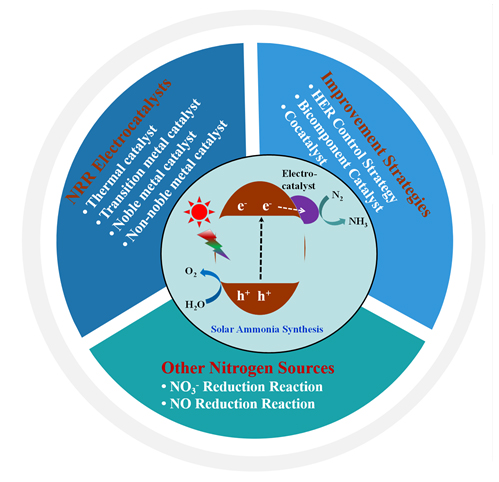摘要/Abstract

氨不仅是重要的化肥化工原料, 还是理想的清洁能源载体. 目前人工氨合成主要基于Haber-Bosch过程, 但该方法存在能耗大、转化率低、大量排放温室气体等问题. 相比而言, 利用太阳能催化转化N2和H2O等制NH3是一条实现太阳能至化学能转化的绿色制氢储氢一体化路线, 受到世界各国科学家的高度关注. 但当前该技术路线的氮还原(NRR)转化率和法拉第效率均较低, 开发高效NRR电催化剂并将其与捕光材料耦合是实现高效太阳能催化合成氨的关键. 本综述将首先介绍太阳能催化合成氨的一些基本原理、主要技术路线和基本检测方法, 然后分类介绍传统热催化剂、过渡金属催化剂、贵金属催化剂和非贵金属催化剂等在电催化NRR领域中的应用, 以及提升NRR性能的主要策略和其它氮源(如: NO3 –和NO)电催化合成氨的研究进展, 最后就该方向存在的一些问题以及急需突破的方向进行了总结与展望.
关键词: 合成氨, 电催化, 氮还原, 太阳能转化, 硝酸根还原, 一氧化氮还原
Ammonia is not only an important chemical for fertilizer and industrial chemical, but also an ideal carrier of clean energy. Current ammonia synthesis is mainly based on Haber-Bosch process that suffers from some problems such as high energy consumption, low conversion and large amount of greenhouse gas emission, so the solar ammonia synthesis from N2 and H2O has recently attracted extensive attention. However, both conversion and Faradaic efficiency via the solar-based catalysis have been still retarded by poor surface catalysis process. Accordingly, development of efficient electrocatalysts for N2 reduciton reaction (NRR) as well as their coupling with photoadsorbers is highly desirable. The recent research progress in the following areas is summarized in this review: i) main electrocatalysts for NRR, including thermal catalyst, transition metal catalyst, noble metal catalyst and non-noble metal catalyst, ii) typical strategies to improve the NRR performance and iii) other routes using different nitrogen sources such as NO3 – and NO. Finally, the remaining challenges and perspectives will be outlined.
Key words: ammonia synthesis, electrocatalysis, reduction of nitrogen, solar energy conversion, NO3– reduction, NO reduction
PDF全文下载地址:
点我下载PDF
